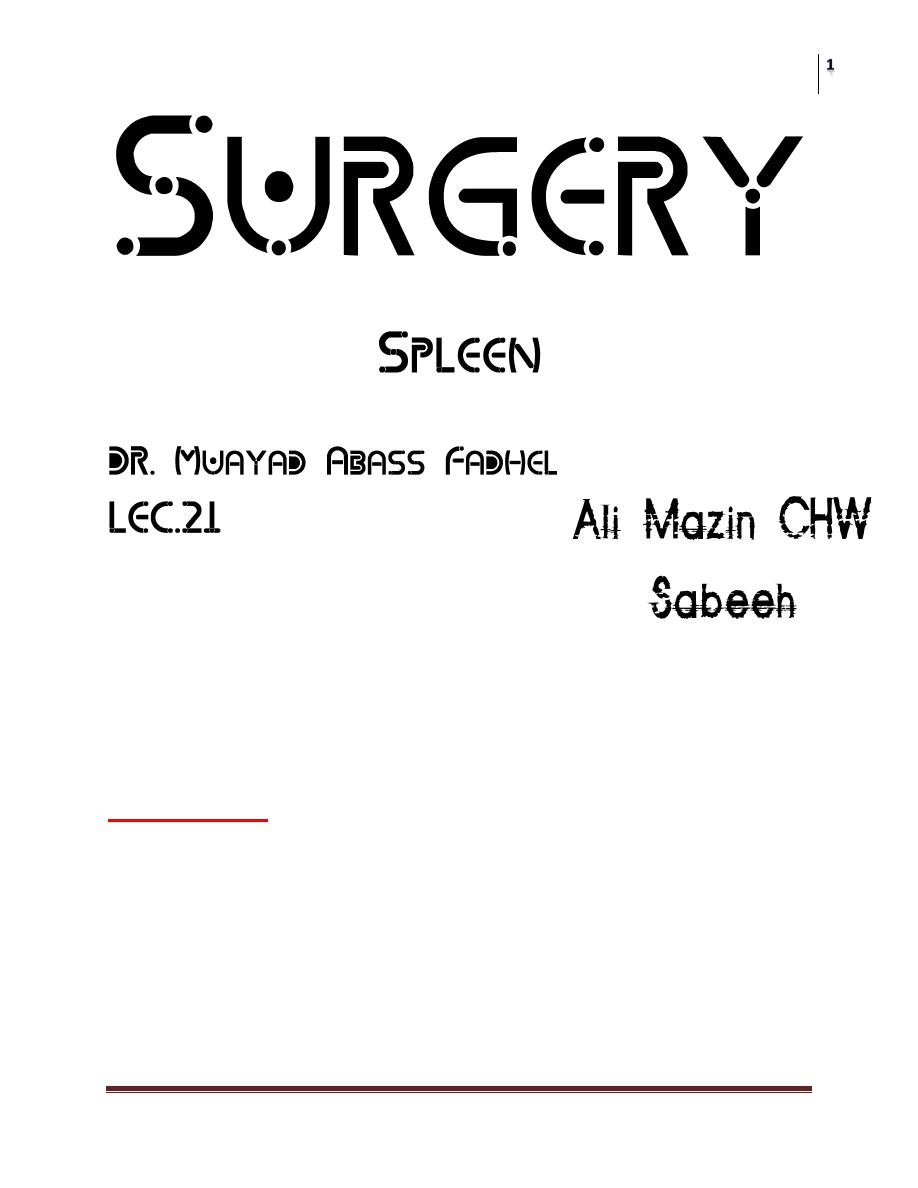
Surgery
Spleen
Dr. Muayad Abass Fadhel
Lec. 21
Anatomy
The weight of the normal adult spleen is
75-250 g.
It lies in the
left hypochondrium
between the
gastric fundus and the left
hemidiaphragm
, with its long axis lying along the
1Oth rib
.
There is a
notch on its inferolateral border
, and this may be palpated
when the spleen is enlarged.
Blood supply:
The tortuous splenic artery
arises from the
coeliac axis
and runs along
the upper border of the body and tail of the pancreas,to which it gives
small branches.
The
short gastric
and
left gastroepiplolc branches
pass between the
layers of the
gastrosplenic ligament
.
The
main splenic artery
generally divides into
superior and inferior
branches, which, in turn, subdivide into
several segmental branches.

Surgery
Spleen
Dr. Muayad Abass Fadhel
Lec. 21
Venous drainage:
The
splenic vein
is formed from several tributaries draining the hilum.
The vein runs behind the pancreas, receiving several small tributaries
from the pancreas before joining the
superior mesenteric vein at the
neck of the pancreas to form the portal vein.
The lymphatic drainage:
The lymphatic drainage comprises efferent vessels in the white pulp that
run with the arterioles and emerge from nodes at the hilum.
These nodes and lymphatics drain via retropancreatic nodes to the
coeliac nodes.
FUNCTIONS OF THE Spleen
Although the spleen was previously thought to be dispensable,
increasing knowledge of its function has led to a conservative approach
in the management of conditions involving the spleen'
The surgeon normally should Endeavour to preserve the spleen to
maintain the following function:
Immune function
.
The spleen processes foreign antigens and is the major site of specific
immunoglobulin M (lgM) production.
Filter function.
Macrophages in the reticulum capture cellular and non-cellular material
from the blood and plasma. This will include the removal of effete platelets
and red blood cells.
Pitting
: Particulate inclusions from red cells are removed and the repaired
red cells are returned to the circulation. These include Howell-Jolly and
Heinz bodies, which represent nuclear remnants and precipitated
haemoglobin or globin subunits respectively.
Reservoir function
:
This function is less marked than in other species,but the spleen does
contain approximately 8 % of the red cell mass.An enlarged spleen may
contain a much larger proportion of the blood volume.

Surgery
Spleen
Dr. Muayad Abass Fadhel
Lec. 21
Cytopoiesis
:
From the fourth month of intrauterine life, some degree of haemopoiesis
occurs in the fetal spleen.
Stimulation of the white pulp may occur following antigenic challenge,
resulting in the proliferation of T and B cells and macrophages. This may
also occur in myeloproliferative disorders, thalassaemias and chronic
haemolytic anaemias
Investigation:
A- Laboratory examination
:
SPLENOMEGALY with
haemolytic anaemia
a full blood count,
reticulocyte count and tests for haemolysis will determine the cause
of the anaemia.
Splenomegaly associated with portal hypertension caused by
cirrhosis is diagnosed on the history, physical signs of liver
dysfunction, and abnormal tests of liver function and endoscopic
evidence of oesophageal varices.
Splenomegaly are associated with lymphadenopathy investigation
should be directed at those disease processes known to be
associated with both physical signs. Lymph node biopsy may be
required.
B- Radiological imaging:
plain radiology:
Calcification
of the splenic artery or spleen may rise the diagnosis of
splenic artery aneurysm
,
old infarct
,
benign cyst or hydatid cyst.
Multiple area of calcification
may suggest tuberculosis of the
spleen.
ultrasonography:
Determine the
size and consistency
of the spleen and whether the
cysts
are presents
.
Computed tomography scan: with contrast enhancement is better to
charectarize the nature of splenic pathology and to exclude other
intraabdominal pathology.
magnetic resonant image scan similarly useful
Radioisotope scan sometimes used to give information about the
spleen.

Surgery
Spleen
Dr. Muayad Abass Fadhel
Lec. 21
Technetium 99 labelled colloid
Is restricted to determine whether the spleen
is the site of red blood
cell destruction.
Splenic artery aneurysm
Aneurysms involving the splenic artery are estimated to occur
at
0.04%
of post-mortem examinations.
It is common in the
female
and are usually situated in the
main
arterial trunk.
It may result as a consequence of
intra-abdominal sepsis
and
pancreatic necrosis
.
They are more likely to be associated with
arteriosclerosis in elderly
patients.
The aneurysm is
symptomless unless it ruptures
.
It is
unlikely to be palpable
, although a
bruit may be present
.
half of the cases
of rupture occur in patients
younger than 45 years
old,
And quarter
is in pregnant women
, usually in the third trimester of
pregnancy or at labour.
The treatment of choice is
splenectomy and removal of the diseased
artery.
Embolisation following selective splenic artery angiography
can be
considered in the unfit patient.
In the
younger patient with an asymptomatic splenic artery
aneurysm, surgery is indicated after CT scan, MRI or selective
coeliac angiography has confirmed the diagnosis.
.In the
elderly patient with a calcified aneurysm
, there is
less risk of
rupture and observation
may be preferred.
Splenic rupture
-Splenic rupture should be considered in any case
of blunt abdominal
trauma
, particularly when the injury occurs to the
left upper quadrant
of the abdomen
Splenic injury should be considered if there are
fractures of the
overlying ribs.

Surgery
Spleen
Dr. Muayad Abass Fadhel
Lec. 21
Iatrogenic injury to the spleen remains a frequent complication of any
surgical procedure
, particularly those in the left upper quadrant when
adhesions are present
Ruptured spleen may present in three ways:
1-
The patient succumb rapidly from massive hemmorrage
:
as a consequence of
trauma or slippage of a pedicle suture
may lead to
rapid exsanguination.
2-
Initial shock, recovery,signs of late bleeding
:
The initial shock is due to blood loss, tamponade occurs and then further
bleeding.
General signs of internal haemorrhage may be variable but local
signs include
left upper quadrant guarding and tenderness,
followed
by
abdominal distension.
Kehr's sign:
The referral of pain to the left shoulder can be demonstrated some
15 minutes following elevation of the foot of the bed.
The pain results from the contact of blood with the undersurface of
the diaphragm and is mediated through afferent fibres of the phrenic
nerve.
Shifting dullness
may be present in the flanks and
fullness in the
pelvis may be evident on rectal examination.
Abdominal ultrasonography or CT scanning will demonstrate the
source of the bleeding in the patient who is stable enough to
undergo imaging before urgent laparotomy.
3-
The delayed case:
The initial signs of splenic injury may
pass quickly or not be
recognised but delayed rupture can occur after few days.
Management:
The ruptured spleen can be
managed successfully without operation.
Careful observation
can be pursued in the patient
with minimal or no
abdominal findings
and when there is
haemodynamic stability .

Surgery
Spleen
Dr. Muayad Abass Fadhel
Lec. 21
CT may confirm isolated injury to the spleen and a conservative
approach should be considered in the absence of hilar involvement or
massive disruption of the spleen.
Immediate laparotomy
is indicated for splenic trauma if
there is obvious evidence of continuing blood loss despite adequate
resuscitation
laparotomy should be considered if there is a strong suspicion of
trauma to other organs.The treatment of associated injuries is
dictated by the operative findings.
Splenic preservation
should be considered where possible
Minor capsular parenchymal injuries may require only topical
haemostatic agents.
If by careful compression of the spleen the bleeding can be
controlled, suture of the injury with or without application of
haemostatic agents may be useful.
Parenchymal injuries involving the lower or upper pole of the spleen
may be managed by partial segmental resection.
Splenomegaly:
Common feature of many disease processes
A-infective
Bacterial
1. Typhoid and paratyphoid
2. Typhus
3. Tuberculosis'
4. Septicemia
5. Splenic abscess
6. Spirochoeta Weils disease
7. Syphilis
Viral
1. infectious mononucleosis
2. HIV-related
3. Protozoal and parasitic
4. Malaria
5. Schislosomiosis'

Surgery
Spleen
Dr. Muayad Abass Fadhel
Lec. 21
6. Trypanosomiasis
7. Kalazar
8. Hydatid cyst
B-Blood disease
1. Acute leukaemia
2. ldiopathic thrombocytopenic purpura
3. Chronic leukaemia
4. Perniciouose anemia
5. Hereditory spherocytosis
6. Autoimmune hemolytic anemia
7. Polycythemia vera
8. thalassemia
9. Erythroblastosis fetalis
10.
sickle cell anemia
C- Metabolic
1. Rickets
2. Amyloid
3. Porphyria
4. Gaucher's disease
D- Circulatory
1. lnfarction
2. Portal hypertension
3. Segmental portal hypertension (pancreatic carcinoma,splenic vein
thrombosis)
E-Collagen disease still disease
Felty syndrome
F-Non parasitic cysts congenital
Acquired
G-Neoplastic Angioma
Primary fibrosarcoma
Hodgkin's lym phoma
other lymphomas
Myelofibrosis

Surgery
Spleen
Dr. Muayad Abass Fadhel
Lec. 21
Hypersplenism:
Is an indefinite clinical syndrome that is charectarized by
splenic
enlargement
,any combination of
anemia,leucopenia or
thrombocytopenia
,compensatory
bone marrow hyperplasia
and
improvement after splenectomy
.
Splenic abscess
Splenic abscess may arise from an
infected splenic embolus
or
in association with
typhoid and paratyphoid fever
,
osteomyelitis, otitis
media
and
puerperal sepsis
.
It may be associated with
pancreatic necrosis or other intra'
abdominal infection.
An abscess
may rupture
and form a
left subphrenic abscess
or result
in
peritonitis
.
The treatment involves that of the
underlying cause
and drainage of
the
splenic abscess by percutaneous
means under radiological
guide.
Neoplasm:
Haemangioma :
is the
most common benign tumour
of the spleen and may develop rarely
into a haemangiosarcoma that is managed by splenectomy.
Lymphoma:
is the
most common cause of neoplastic enlargement
, and splenectomy
may play a part in its management.
Splenectomy may be required to
achieve a diagnosis
in the absence of
palpable lymph nodes or to
relieve the symptoms
of gross splenomegaly.
Myelofibrosis:
Is due to an
abnormal proliferation of mesenchymal elements in the bone
marrow
.
spleen
,
liver and lymph nodes
.
Most patients present over the age of 50 years and the spleen may
produce pain owing to its gross enlargement or from splenic infarcts,
Splenectomy reduces the need for transfusion and may relieve the
discomfort resulting from the splenomegaly
The spleen is rarely the site of metastatic disease.

Surgery
Spleen
Dr. Muayad Abass Fadhel
Lec. 21
Splenectomy
-open splenectomy:
- laparoscopic splenectomy
Indication:
1-
Trauma
resulting from an
accident
or
during a surgical procedure
, as for
example during mobilisation of the oesophagus, stomach, distal pancreas
or splenic flexure of the colon.
2-
Removal enbloc with the stomach
as part of a
radical gastrectomy
or with
the
pancreas as part of a distal or total pancreatectomy
.
3- To reduce
anaemia
or
thrombocytopenia
in
spherocytosis
,
idiopathic thrombocytopenic purpura
or
hypersplenism.
4-In association with
shunt or variceal surgery
for
portal hypertension.
Preoperative preparation:
In the presence o f a bleeding tendency, transfusion of blood,fresh-
frozen plasma, cryoprecipitate or platelets may be required.
Antibiotic prophylaxis appropriate to the operative procedure Should
be given and considirartion given to the risk of postsplenectorny
Sepsis.
Postoperative complications
Immediate complications
:
1-
hemorrhage
resulting from the
slipped ligature of splenic artery
.
2-
Haematemesis
from gastric mucosal damage and gastric dilatation.
3-
left basal atelactesis
and
pleural effusion
.
4-
adjacent structure injury like stomach and pancrease
. Aflistula may result
from damage to the greater curvuture of the stomach during ligation of the
short gastric vessels. Damage to the tail of the pancreas may result in
pancreatitis, localized abscess or a pancreatic fistula.
5- The blood platelet count may Rise in number resulting in axillary and
other venous thrombosis. Aspirine is indicated

Surgery
Spleen
Dr. Muayad Abass Fadhel
Lec. 21
Post-splenectomy septicaemia:
may result from
Streptococcus pneumonia
,
Neisseria meningitides
,
Haemophilus influenzae
and
Escherichia coli
.
The risk is greater in
-
young patient
-Splectomized patient
treated with chemoradiotherapy
-Patient undergo splenectomy for
thalassemia,sickle cell
anemia and autoimmune anemia.
Opportunistic postsplenectomy infection(OPSI):
children who have undergone splenectomy before the age of five
years should be treated with daily dose of pencillen until the age of 10
years.
The risk of this overwhelming infection is more within the fist 2-3
years of splenectomy.
Satisfactory oral prophylaxis can be obtained with penicillin,
erythromycin or amoxicillin or co-amoxiclav.
Suspected infection can be treated intravenously with these same
antibiotics and cefotaxime, ceftriaxone or chloramphenicol in patients
allergic to penicillin and cephalosporins.
If elective splenectomy is planned, consideration should be given to
vaccinating
against pneumococcus, H. influenzae and
meningococcus.
Pneumococcal vaccinatictn
is recommended in those patients aged
over 2 years
.
Haemophilus influenzae
vaccination is recommended
irrespective of
age
.
Meningococcal vaccination
is not recommended routinely unless the
individual is considering travel to areas where there is a risk of
infection, in local outbreaks and for contacts with infected cases.
It is also recommended that
influenza vaccine
be given to asplenic
patients as influenza has been implicated as a risk factor
for
secondary bacterial infection
.
In the
trauma victim
, vaccination can be given in the post' operative
period and the resulting antibody levels will be protective in the
majority of cases.
Antibody levels are, however
, less than 50% of those achieved if
vaccination is given in the presence of an intact spleen
.
